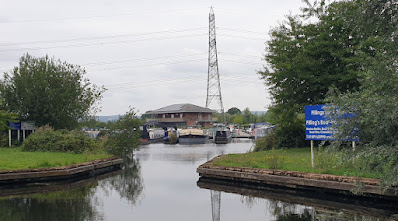Another very grey but dry and satisfactorily warm day, although when we awoke there was a short shower that did not last until before breakfast!
We set off in better time that we at first though - we had had a mini lie in! Our wide beam overnight neighbour was left behind - its genny started almost as soon as the official time of 8 am arrived! We find the noise from such devices, especially when placed as far away from its boat as possible, rather more distracting than the equally close main line railway.
Shortly after setting off we passed the entrance to Pillings Lock Marina. When it opened about a decade ago, it quickly became a cause celebre when its founders were embroiled in a legal spat with CaRT over fees due in order to be connected to the network. It came very close to having its entrance filled in! It gained new owners in 2018 and since then has gradually built a positive reputation, keeping itself well away from media controversy.
Equally quickly we arrived at Pillings Lock itself, a flood lock that protects the whole of the Loughborough Cut.
Althiugh the river itself continues over this weir we did notice when on our overnight mooring that the flow was quite fast. We are not aware of places where it might allow water back into the river but the bypass weirs at the two locks were only moderately overflowing.
Water management is aided by another radial gate which opens and closes automatically - according to the warning signs.
As Mike was preparing the lock, with Christine waiting with the boat on the lock landing, a wide beam trip boat from the Peter le Marchant Trust in Loughborough arrived. Christine, not realising that they were a wide beam, offered to let them into the lock first as they were having a little difficulty fitting in to the remaining space on the lock landing. Only when they passed did she realise that we could not fit alongside them! As we were not on a tight schedule today, we were thinking about letting them pass anyway. We then had to wait as a single-hander came down.
What happened next is best not written about but let us say that some boaters, even those who think that they know all about locks and boat handling should remember that it is the boat in the lock which is in charge and his/her instructions followed at all times . . .
Above the lock another sad sight. Perhaps CaRT will find a way to move it soon as it is unhelpfully block part of the lock landing, making it a bit difficult for a large boat to leave upstream when a downstream boat just arrives.
Around the corner is a cafe and hire base with an eclectic collection of small brightly coloured pedal boats and other means of staying afloat.
With such a deep lock it is not a surprise that the weir stream is quite substantial. The river takes quite a wide sweep away from the line of the canal (or perhaps we should say that the short lock section cuts off quite bit of distance)
We then passed under the modern A6 which are unlikely to forget for some as we were shot at when we came by in 2021 and a window shattered. We heard later that several boats suffered similar experiences that day. (see)
The former railway viaduct at Mountsorrel is so iconic and architecturally impressive (little doubt of its Grade 1 listing) and we cannot resist yet another photo. Despite its substantial size, the line that ity carried was a mineral line that connected the large nearby Mountsorrel Quarry to the Midland Main Line near Barrow and also to the Great Central at Swithland. It closed in the 1950's. The quarry, however, is still very much in operations and is the source of a particular pink coloured stone (see) It is now part of the Tarmac group. The section from Swithland to Mountsorrel was been re-laid by the preserved railway a few years ago and there hopes that it will carry passengers before very long.
Sileby Mill is alongside the lock that also bears this name. The boatyard here were very helpful in replacing out smashed window.
It was well into lunch hour when we came up Cossington Lock and we paused on the very end of the lock landing, nearest in this photo, looking back after we left a while later.
Only a short distance was left for the afternoon cruise - just to and up Junction Lock. Whilst Mike opened the gates, Christine expert brought the boat in, not touching the side or gate until well into the chamber.
The name Junction Lock comes from a short distance upstream where the Melton Mowbray and Oakham joined the River Soar, which had already been made navigable a little earlier when the canal was built. The first part is largely based on the River Wreake but beyond Melton Mowbray it is a conventional canal to Oakham. Serving a predominantly rural area, neither navigation was especially financially successful (particularly the Oakham half) and it closed finally in 1877 (the Oakham ceased thirty years earlier). Interestingly this summer, the canal suffered substantially when it had to close for five months in a very dry summer of 1844. Nothing new there, then.
6.4 Miles - 5 Locks
















No comments:
Post a Comment